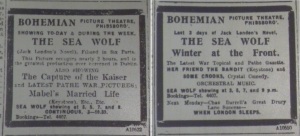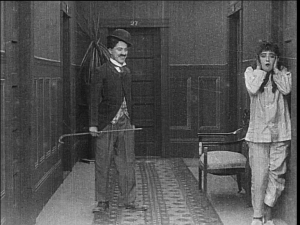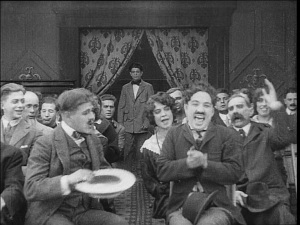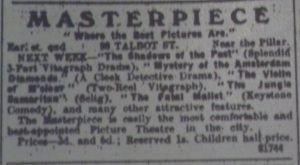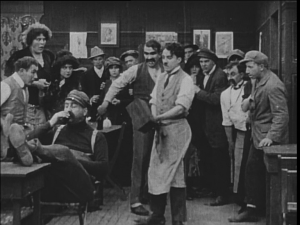Denis Condon’s blog Early Irish Cinema looks back at the early development of cinema in Ireland on the anniversaries of those developments and offers information on what cinemagoers could have seen in Irish cinemas a century ago. Here Denis takes a look at how Irish audiences took a while to warm to the delights of Charlie Chaplin.
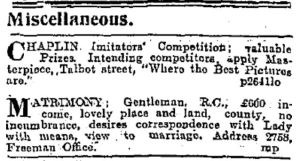 Small ad calling for Chaplin imitators. Freeman’s Journal 16 Sep. 1915: 8.
Small ad calling for Chaplin imitators. Freeman’s Journal 16 Sep. 1915: 8.
By October 1915, a Charlie Chaplin craze was in full swing in Dublin. Paddy, the Irish correspondent of the British cinema trade journal Bioscope, showed this when he reported on several simultaneous tributes to Chaplin less than two years after he made his first film. On 7 October, Paddy revealed that Captain Ahearne of the Dame Street Picture House had shown all-Chaplin programmes the previous week, while a live Chaplin revue at the Coliseum Theatre had distinguished itself from the Chaplin impersonation competition taking place at the Rotunda by featuring what Paddy claimed was “the only Chaplin girl extant” (Paddy, 7 Oct.). That such competitions were not wholly new was shown by the fact that Cathal MacGarvey manager of the Masterpiece Theatre, Talbot Street was exhibiting his film of a Chaplin impersonation competition that had taken place at his picture house in September (Paddy, 14 Oct.). Chaplin seemed to be everywhere you looked by the autumn of 1915. But this adulation had taken some time to grow.
The Bohemian Picture Theatre showed Mabel’s Married Life in the first three days of the week beginning 30 Nov. 1914 and Her Friend the Bandit for the last three days of that week. Evening Telegraph 30 Nov. and 3 Dec. 1914.
Irish audiences’ decades-long love affair with Charlie Chaplin, the biggest film star of the first half of the 20th century, began modestly a century ago. Cinema audiences in Ireland, like those around the world, knew the slapstick comedies for which Mack Sennett’s Keystone Film Company was already famous when Chaplin joined in December 1913. When he began shooting his first films in January 1914, Chaplin played supporting roles to such better-established comics as Mabel Normand, Roscoe “Fatty” Arbuckle and Ford Sterling. However, he rapidly became the star player in films that he directed himself. Nevertheless, he did not renew his Keystone contract in December 1914, choosing instead to join George K. Spoor and Gilbert M. “Broncho Billy” Anderson’s Essanay Film Manufacturing Company.
As the best remembered of the stars who emerged in the 1910s, Chaplin has already been discussed briefly here and here. Now that the centenaries of his year at Keystone have passed, it may be worth looking in more detail at the Irish reception of this initial stage of his career. Almost all the Keystone films he appeared in have survived, and thanks to the Chaplin Keystone Project, these have been restored to as watchable a condition as possible and are available in the DVD collection Chaplin at Keystone, accompanied by an informative booklet. Despite the films’ flashes of brilliance, however, it is hard not to agree with David Robinson that “[w]e can only look back at the first few Keystone films and see a crude, unfinished form, and the earliest tentative search for a screen character” (130). But as Robinson goes on to argue this is our problem in retrospect: “To the audiences of the time they were new and astonishing. From the very start, Chaplin had created a new relationship with the audience, provoking a response that no one had elicited before in film or in any other medium” (ibid).
Irish audiences’ first sight of Chaplin on screen was not as a tramp but as a “sharper” in Making a Living (US: Keystone, 1914).
Surviving accounts from Irish audience members are rare, but newspapers do offer some clues about how that relationship began in Ireland. These clues have to sifted out of ads and articles that are largely the product of the marketing needs of film production companies, distributors, picture houses and the newspapers that carried the material. Most of the cinema display ads, preview and reviews in Dublin newsaper were for the few picture houses that paid for advertising. The most regular picture-house advertising was from the Rotunda Pictures in Dublin’s O’Connell/Sackville Street, which had long used extensive advertising to construct its reputation as the city’s premier picture house. In roughly descending order of regularity of advertising, the Rotunda was followed in late 1914 and early 1915 by the Bohemian Picture Theatre in Phibsboro; the Masterpiece Theatre in Talbot Street; the Provincial Cinematograph Theatres pictures houses in Grafton and O’Connell/Sackville Streets; the Phoenix on Ellis Quay; the Dorset Picture Hall; the Volta in Mary Street; the Electric Theatre in Talbot Street; Dame Street Picture House; and the Pillar Picture House in O’Connell/Sackville Street. This represents just two-fifths of Dublin city’s cinemas, and many of those named often did not mention the titles of the short comedies that supported the main dramatic feature. Nevertheless, the display ads, previews notices and reviews of these picture houses allow us to track the release dates and something of the reception of Chaplin during his year at Keystone.
This review of the programme at the Rotunda Pictures gives a good indication of where comedies featured in the priorities of newspaper reviewers. Evening Telegraph 23 Jun. 1914: 2.
It was at the Rotunda that Chaplin first appeared on a screen in Dublin in the comedy Making a Living (US: Keystone 1914), which had a three-day run beginning on Monday, 21 June 1914. The Evening Telegraph’s review suggests that contemporary observers did not share the importance we would likely attribute to the beginning of Chaplin’s career. The highlight of the bill on which Making a Living appeared was for at least the nationalist members of the audience – as it was for the reviewer in the nationalist Evening Telegraph – “a splendid film showing the pilgrimage to Wolfe Tone’s grave, at Bodenstown, on Sunday” (“Rotunda Pictures,” 23 Jun.). This local topical (news film) “was received with possibly the greatest of applause yet extended to any film previously shown at this house,” and its exhibition was enhanced by the Irish Ladies’ String Orchestra playing “The Volunteers’ March”: “The opening bars of the martial music were drowned by the tumultuous cheering of the crowded audience” (ibid.). By contrast, Making a Living was merely mentioned in passing along with two other comedies that were also part of the programme.
Western Import Co. ad for Chaplin’s early Keystone films hails him as the hit of the season and reminds readers of his stage career. Bioscope 9 Jul. 1914: xx.
Making a Living was almost five months old by the time it reached Irish screens. It had been shot on 5-9 January 1914 and first released is the United States on 2 February 1914 (Chaplin at Keystone). From 21 June on, however, Chaplin’s films were released in Ireland in quick succession but not always in the same order as they had appeared in the US. This release pattern and much of the publicity material available to picture house managers came from the Western Import Company, the British and Irish distributor of all Keystone films. All the films released by Western Import up to the end of January 1915 were shown in Dublin. Western Import was based in London, and its ads in the trade papers reflected the fact that Chaplin’s films had been a particular hit in the US and were likely to be at least as popular in Britain where he had recently been a music-hall comedian.
In Mabel’s Strange Predicament, Dublin audiences saw Chaplin in his tramp costume for the first time, harassing Mabel Normand in her pyjamas.
Despite the information available from the distributor, the names of Mabel Normand or Ford Sterling were more likely to have caught the attention of comedy audiences that week. When Mabel Strange Predicament – the film in which Chaplin first appeared as the tramp – began its three-day run at the Rotunda on 2 July, the Dublin Evening Mail did not mention Chaplin but commented of Normand that “this little lady is now the leading comedienne in filmland” (“Rotunda Pictures,” 27 Jun.). And when Chaplin’s next film, Kid Auto Races at Venice, Cal., was appreciatively reviewed during its Rotunda run (6-8 July), the reviewer misidentified Chaplin as Keystone’s more established Fatty Arbuckle, observing that the “famous ‘Fatty’ of the Keystone company, will be seen in a screamingly funny picture, ‘Kid Auto Races’” (“Rotunda Pictures,” ET 7 Jul.). This pattern was not confined to the first few of Chaplin’s films screened in Dublin but continued up to November, when Mabel’s Busy Day was described as “one of the funniest adventures of Mabel Normand, Keystone Company” (“Rotunda Pictures,” ET 21 Nov.). Although “[a]mongst the humorous contributions” to the bill at the Masterpiece on 22 December “Chaplin, of the Keystone Co., in ‘A Busy Day,’ was very amusing,” this did not distinguish him from Ford Sterling who had left Keystone for a time and was starring “in a highly diverting Sterling Comedy, ‘Three O’clock’” (“Masterpiece”).
As this suggests, Keystone was itself a brand that newspaper advertisers and reviewers expected readers to recognize. This was emphasized on 10 October, when a preview of the Rotunda’s programme recommended When Reuben Fooled the Bandits – featuring the lesser known Keystone player Charles Murray – on the sole basis that it was a Keystone, “which means the last word in comedy” (“Rotunda Pictures,” ET 10 Oct.). The company brand and the star brand were also frequently combined. On 17 October, the preview of the Masterpiece Theatre did not specify the title of the comedy films that would be on show in the following week, but one of them “is a highly diverting Keystone, featuring the inimitable [C]haplin” (“Masterpiece Theatre”).
All the Keystone films featuring Chaplin released onto the British market between late June 1914 and the end of January 1915 were shown in Dublin, and many of them had their first Dublin exhibition on or close to the day Western Import released the film. Some films, however, appear to have been screened weeks or months after the release date, but it is possible that they were screened earlier and in the period before the attractiveness of Chaplin’s name was fully realized, their titles were not mentioned in the press. In any case, Making a Living’s appearance at the Rotunda on 22 June was four days after its London release. Mabel’s Strange Predicament appeared at the Rotunda on 2 July, a week and a half after its 22 June release (“Rotunda Pictures,” DEM 27 Jun.). Kid Auto Races at Venice, Cal. was release on 2 July and shown at the Rotunda on 6 July (“Rotunda Pictures,” ET 7 Jul.). Released on 6 July, A Thief Catcher – staring Ford Sterling but featuring Chaplin – ran at the Picture House, Grafton Street (9-11 July; ad, ET 9 Jul.), before the Rotunda (13-15 July; “Rotund Pictures,” ET 11 Jul., II 13 Jul.), and this seems also to have been the case with Between Showers, which was released on 9 July and exhibited first at the Grafton on 13-15 July (“Grafton Street Pictures”). A Film Johnnie was released on 13 July and shown at the Rotunda beginning on 20 July (“Rotunda Pictures,” ET 21 Jul), and His Favourite Pastime seems to have screen first at the Picture House, O’Connell/Sackville Street a week after its 20 July release (ad, ET 25 Jul.).
Chaplin’s character in A Film Johnnie begins in a picture house and travels to the Keystone studios in pursuit of the Keystone Girl.
No Chaplin film appears to have been released in August 1914, but September was busy. Tango Tangles – featuring Chaplin, Arbuckle and Sterling – was released on 10 September and shown at the Picture House, Sackville/O’Connell Street from 14 September (“O’Connell Street Pictures”). Cruel, Cruel Love’s 17 September release was followed by a 21 September Dublin opening at the Rotunda (“Rotunda Pictures,” ET 19 Sep.). Caught in the Rain was released on 21 September but does not seem to have had a Dublin screening until it was exhibited at the Volta’s well-advertised Sunday shows on 13 December (“Volta,”). Similarly, “Keystone screamer” Twenty Minutes of Love awaited a 17 January 1915 showing at the Volta despite a 28 September 1914 release (“Volta,” 16 Jan.).
Ad for the Masterpiece programme for the week, including The Fatal Mallet; Evening Telegraph 12 Dec. 1914: 1.
Although October 1914 also saw no Chaplins released, November and December made up for it. The 9 November release of Caught in a Cabaret coincided with the same-day opening at the Rotunda (“Rotunda Pictures,” ET 7 Nov.). A Busy Day waited more than a month after its 12 November release until its Dublin premiere at the Masterpiece on 21 December (“Masterpiece”); the previous week (17-19 Dec.), the Masterpiece had shown The Fatal Mallet, which had been released on 19 November (ad, ET 12 Dec.). Mabel’s Busy Day had a release-day opening at the Rotunda on 23 November (“Rotunda Pictures,” ET 21 Nov.), and Mabel’s Married Life also opened in Dublin the day it was released at both the Rotunda and Bohemian on 30 November (“Rotunda Pictures,” ET 1 Dec.; “Bohemian”). On 3 December, the Bohemian gave Her Friend the Bandit an opening-day release (ad, ET 3 Dec.). And finally, Laughing Gas opened at the Picture House, O’Connell/Sackville Street on 7 January 1915, three days after its 4 January release (ad, ET 7 Jan.).
Chaplin prepares to deal with a difficult customer in Caught in a Cabaret.
Very few of these 18 films were given more than a cursory mention. At the Rotunda in November, Chaplin’s Caught in a Cabaret was given unusual prominence for a comedy by being named as the first “of the principal films of the week” and as “a real live Keystone, one of the funniest yet” (“Rotunda Pictures,” ET 7 Nov.). “‘Caught in a Cabaret’ is the title of one of the best comedy pieces in cinematography yet shown in Dublin, and which is to be seen at the Rotunda Picture House. In all its details it proved a most laughable piece and drew forth loud applause” (“Rotunda Pictures,” ET 11 Nov.). Caught in a Cabaret was also popular at the Kelvin Palace in Bangor at Christmas:
Five performances were held on Christmas Day, and a like number of St Stephen’s [26 Dec.], at each show a complete change of pictures being screened – ten programmes in the two days. To be strictly accurate I should mention tha tone picture was retained in each programme. It was the screamingly-funny two-reel Keystone, “Caught in a Cabaret.” (“Jottings.”)
The most notice any Dublin newspaper reviewer gave to Chaplin in this initial period came at the end of July. “A splendidly long and most amusing comedy is ‘A Film Johnnie,” observed the Evening Telegraph’s columnist, noting the film’s reflexivity. “This picture features Charles Chaplin going to a cinema, where owing to an infatuation for a girl in the screen he creates great trouble in a most laughable manner” (“Rotunda Pictures” ET 21 Jul.). The Irish Times reviewer did not name Chaplin – referring merely to the “young man” in this “real good comedy series” – but commented that the “operations of the fire brigade in regard to that individual are the cause of much laughter” (“Rotunda Pictures,” IT 21 Jul).
Looked at week-to-week, Chaplin’s rise to fame looks more incremental than meteoric, but it would only be a few months before many members of the Dublin audience wanted to be Charlie.
Denis Condon lectures in film at NUI Maynooth.
Contact: denis.j.condon@nuim.ie
References
“Bohemian Picture Theatre.” Evening Telegraph 1 Dec. 1914: 4.
Chaplin at Keystone. DVD Collection. London: BFI, 2010.
“Grafton Street Pictures.” Evening Telegraph 14 Jul. 1914: 2.
“Jottings from Ulster.” Bioscope 14 Jan. 1915: 146.
“Masterpiece.” Evening Telegraph 22 Dec. 1914: 6.
“Masterpiece Theatre.” Evening Telegraph 17 Oct. 1914: 6.
Paddy. “Pictures in Ireland.” Bioscope 7 Oct. 1915: 57; 14 Oct. 1915: 217.
Robinson, David. Chaplin: His Life and Art. London: Penguin, 2013.
“Rotunda Pictures.” Dublin Evening Mail 27 Jun. 1914: 3.
“Rotunda Pictures.” Evening Telegraph 23 Jun. 1914: 2; 7 Jul. 1914: 2; 14 Jul. 1914: 2; 21 Jul. 1914: 2; 19 Sep. 1914: 6. 7 Nov. 1914: 6; 11 Nov. 1914: 4; 21 Nov. 1914: 5; 1 Dec. 1914: 4.
“Rotunda Pictures.” Irish Independent 13 Jul. 1914: 5.
“Rotunda Pictures,” Irish Times 21 Jul. 1914: 7.
“The ‘Volta’ Sunday Pictures.” Evening Telegraph 13 Dec. 1914: 6; 16 Jan. 1915: 2.

